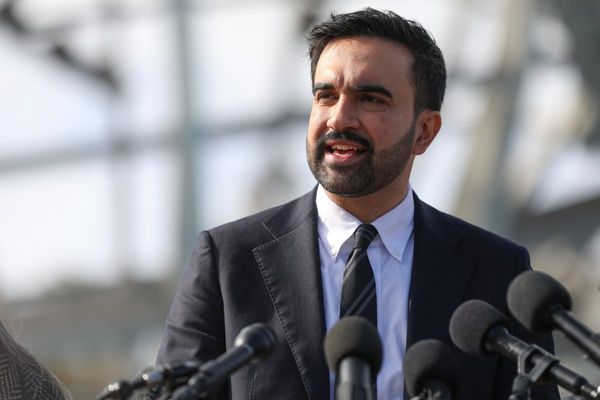

CONTENT WARNING: This article discusses suicide.
There’s certainly been a lot for Australia’s young people to contend with in recent years, including issues pretty much out of our control (cost of living, housing, the climate crisis — take your pick) that’s left us drained and hitting a wall. Suicide Prevention Australia’s latest Community Tracker — a quarterly survey looking at suicidal behaviours, and the social and economic issues are driving distress — has now shed a damning light on just how much Gen Z may be struggling.
In the last 12 months, one in four young people (between 18-24 years old) have experienced suicidal thoughts or behaviour. That’s nearly a quarter of young people struggling, compared to one in seven Aussies more broadly.
Speaking to PEDESTRIAN.TV, Suicide Prevention Australia’s acting chief Chris Stone admitted the figures left him “sad, but not surprised”.
“There are a range of issues young people face today that are significantly worse than in past decades. We need to understand what these causes of distress are, and how they are changing, if we are going to reduce suicides,” he said.

What do the statistics tell us?
While suicide is a complex issue driven by many intertwined factors, Suicide Prevention Australia’s latest Community Tracker data shows the causes of distress appear to be shifting.
After a prolonged period of economic pressures, the teeny silver lining appears to be that distress linked to economic and money worries — like personal debt and cost-of-living, unemployment, and housing affordability — is actually starting to dip.
“It’s down five percentage points from its peak in February 2024, and that’s good news,” Stone observed.
But, on the flip side, while economic factors might be slightly less of a headache, social stresses are now on the rise. Family relationships and breakdowns, and social isolation and loneliness are now the second and third largest causes of distress, according to the survey.
“We’re seeing a rise in distress caused by social isolation and loneliness amongst all Australians regardless of age, but this is particularly severe for young Australians aged 18 to 24. Data from our latest survey revealed one in three young Australians reported increased isolation and loneliness, which is a significant jump of around 10 percentage points compared to older generations aged 50 and over,” Stone elaborated.
It’s actually the second biggest stressor now for young Aussies, just behind cost-of-living.
And as for other things weighing on our minds? That would be social media, self-image and bullying, and family relationships and breakdowns.
Amidst all this, there’s also been a marked rise in young people seeking out help, Suicide Prevention Australia found. Almost half (44 per cent) of young people reached out to suicide prevention services in the last year, up 17 percentage points since February.
According to Stone, there’s two things we can take away from these figures: distress levels are rising, but so is a willingness to seek help.
“The worst-case scenario would be if distress was rising, but help seeking remained stagnant or dropped. Instead, we’re seeing the opposite: more young people are finding their way to support,” he pointed out.
Another encouraging sign, Stone continued, has been a jump in help-seeking through community services, like support groups, counselling, and peer networks. This has gone up 15 percentage points in the past year — the highest on record, he noted.
“This shows that despite the isolation young people report feeling, many know they’re not alone, and they’re actively seeking and building support networks. It also shows just how essential these community-based services are, and the need for them to be properly funded and resourced so they can grow and continue to help those who need them,” Stone said.

On the frontlines, what are support services seeing?
Off the back of this help-seeking trend, mental health organisations like ReachOut agreed that more and more young people are seeking support and resources.
In the last 12 months, almost 20,000 Aussies engaged with ReachOut’s support content, specifically about suicide and loneliness, the organisation’s deputy CEO Jackie Hallan told P.TV.
“While we’re encouraged that Suicide Prevention Australia’s new research shows more people are seeking support, we know that means that more young people are in distress too, which is concerning,” she said.
“This new data from Suicide Prevention Australia is a timely reminder for all of us. We acknowledge that these statistics represent young people and their families going through incredibly distressing experiences across the country.”
Reflecting on some of the themes highlighted in the research, Hallan observed some key concerns on young peoples’ minds right now includes loneliness and cost of living, along with stresses about the future, and feeling down or anxious.
Crucially, these elements can also be interconnected, she pointed out.
“It’s important to remember that these concerns can be related too. For example when ReachOut asked young people about the impacts of the cost of living on their lives, they told us that they were cutting back on social activities and taking on more work, which we know could also be impacting their feelings of loneliness and isolation,” she told P.TV.
Headspace national’s head of clinical practice Nicola Palfrey, meanwhile, explained that while the service hasn’t necessarily seen a sudden spike, there’s consistently high demand for mental health services among Australia’s young folk in recent years.
“In terms of people accessing headspace services, in person or online, it remains consistently high. Demand is not necessarily peaking, but reported distress amongst young people continues to be at higher levels, probably similarly high levels since the pandemic,” she explained.
Plus, there’s a number of common elements that seem to be coming up in these conversations, many of which are actually external factors impacting their mental health.
“Cost of living is definitely a primary concern of young people, and then there’s all of the kind of associated issues around that — being able to afford to go out and have social connections, being able to afford to buy a house in the future, concerns around the day-to-day stress of being able to make rent or get a job after university. A lot of those external factors are really pressuring young people, and that’s very difficult when a lot of those things are outside of your control,” Palfrey said.
And in a trend that seems to going up every week, global conflict and geopolitical issues have proven to be key stress factors.
She explained: “A lot of global conflict and uncertainty is pretty destabilising for a lot of young people, either because it’s just the environment or world they live in, or people they know are impacted that live overseas or live here in Australia. So, there’s a lot of macro factors that are impacting young people that they speak to us about.”

Ultimately, while the figures of young people seeking help can be concerning, it also demonstrates a double edged sword, Palfrey told P.TV.
“You build literacy and confidence and reduce stigma, so more people come forward, and the numbers are going to go up. It’s always tricky, when you start reporting on something more accurately because people feel safe to say that they’re feeling worried or they’re feeling anxious or sad. It’s good because we know early help seeking and support can get really good outcomes for young people.”
For Palfrey, compared to the alternative, it’s definitely a green flag to reach out and “be honest about if you’re travelling well or not”.
Investing in young peoples’ future
The growing number of young people reaching out demonstrates a pretty clear need for supporting such mental health services, with a National Suicide Prevention Strategy announced by the federal government earlier this year.
The strategy, unveiled in February, offers a national plan to reduce suicide deaths and attempts by ensuring people can access the right support before they reach crisis point.
“It recognises that workplaces, schools, social services, and everyday Australians all have a role to play in reducing distress and supporting those who are struggling. It’s a good strategy, that is backed by the sector,” Suicide Prevention Australia’s Stone told P.TV.
Unfortunately, there is a critical concern: the strategy, as it stands, is “unfunded and unactioned”.
“We need to be making sure that our attention is on addressing all the stressors that are posing a risk to young people. So, it’s good that the government has put together a plan that directly addresses a range of different causes of suicide. However, this strategy is currently unfunded and unactioned, and no matter how good a plan is, without implementation it is just words on paper,” Stone remarked.

Doubling down, he voiced concern for the future of the country’s Suicide Prevention Research Fund, with federal funding to come to a close on June 30, 2025.
“I also think it’s critical that we continue to ensure that we are keeping up to date with the latest evidence-based strategies to prevent suicide, both in the broader community and among young people. Understanding what’s driving suicide risk among young people starts with good research,” Stone said.
“Now is the time to deepen our understanding — not step back.”
Importantly, there’s a big and dangerous misconception to tackle, which is people thinking they shouldn’t talk about suicide.
There’s still progress to be made in how we approach these conversations, Stone told P.TV, despite some of the declining stigma around mental health and suicide.
“We need to support Australians in understanding that asking someone if they are thinking about suicide won’t plant the idea in their head, but instead can open the door to life saving support,” he said.
“Young Australians are leading the way in having more open conversations about their wellbeing, which is something we should celebrate and support. But we still have work to do, especially in ensuring parents and carers, educators, employers, and peers feel confident and safe to have these conversations. And we need to make sure people have the knowledge of how to connect someone with support if they find they are thinking of harming themselves.”
Stone added: “It’s also important that people keep in mind, especially when considering statistics like ours, that behind every number is a person navigating uncertainty, disconnection, and pressure. And that with the right supports in place, they can — and do — reach out, connect, and recover.”
Help is available.
If you’re in distress, please call Lifeline on 13 11 14 or chat online. If it’s an emergency, please call 000.
Under 25? You can reach Kids Helpline at 1800 55 1800 or chat online.
Reach out to Headspace or Beyond Blue for support, or make an appointment with your GP.
The post Suicide Prevention Services Are Experiencing A Spike From Young People — Here’s Why appeared first on PEDESTRIAN.TV .







